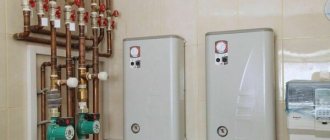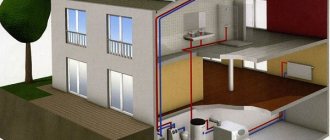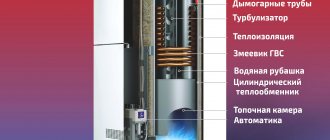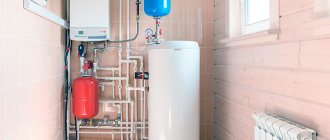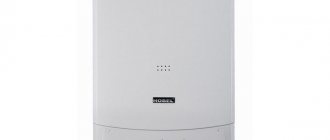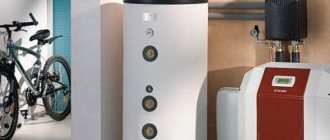A correctly chosen heating system for a home means that the interior decoration, insulation of the ceiling and roof will not rot, and the family budget will not be devastated by paying for the gas consumed. Therefore, there is always a temptation to buy a newfangled model with electronics and fan blowing of the firebox. But consumers forget that a good atmospheric gas boiler is not inferior to turbocharged options, at least in terms of energy efficiency and level of comfort.
Design and principle of operation
Typically, atmospheric gas boilers are perceived as a relic of the past. This is not entirely fair. Heating systems with gas combustion in an open firebox are simpler in design than turbocharged gas boilers, but are not technically primitive.
The atmospheric gas boiler is designed to ensure efficient gas combustion, high heat output and safety with a minimum number of components, especially electronic ones. But the simpler the mechanism, the less often it fails. If we compare the service life of an atmospheric boiler with a gas turbocharged one, the first one will easily last 25-30 years, while models with a closed firebox and turbine last for 10-12 years.
The atmospheric boiler consists of four main components, not counting the body and piping:
- firebox;
- heat exchanger - usually copper or steel;
- gas burner with a set of automation or electronic control system;
- chimney.
A circulation pump may or may not be installed, depending on the heating scheme of the house. An additional independent heat exchanger can also be installed to produce hot water. Independent - this means that it is a separate unit from the main heating heat exchanger. It serves solely to heat the water accumulated in the boiler.
There is nothing to break here except the electronics or the circulation pump. Moreover, only gas boilers with atmospheric combustion can be manufactured in a non-volatile design.
The atmospheric boiler is called so due to the absence of an exhaust fan. The firebox is not isolated from the internal space of the boiler room, so gas combustion occurs naturally. The resulting hot gases flow relatively slowly around the heat exchanger, managing to transfer all the released heat to it.
Features of an atmospheric type furnace gas burner
The flow of air into the firebox occurs due to the vacuum in the chimney pipe. Therefore, an efficient and safe chimney for an atmospheric gas boiler is as important as a high-quality burner.
The operation of the gas burner is based on the principle of air injection:
- A jet of gas escapes under pressure from a hole with a diameter of 0.2-0.6 mm in a bronze nozzle. The excess pressure is small, on average 10-15 kPa, but this is enough for the gas flow to take with it a certain amount of air.
- The gas-air mixture, by inertia, enters the narrow and elongated body of the gas burner. The final mixing of gas and air occurs. The mixture is squeezed out through narrow slots in the burner body and burns.
If the burner and nozzle are adjusted correctly at the factory, the atmospheric boiler burns gas fuel stably and efficiently without regulatory elements. The only thing that may be needed is to cover the pipe with a valve, but this does not affect the efficiency of the atmospheric firebox.
When choosing an atmospheric boiler, you need to pay attention to the design of the gas burner. For well-known brands, the burner device is made of polished stainless steel. The body dimensions are cross-section and diameter, the width of the slots is calculated and adjusted to tenths of a millimeter.
The welding seam is polished so that it cannot be identified by touch. This burner is adjusted to the specific pressure in the gas pipe and the average chimney draft during the heating season; today this is the best option for a home boiler.
Removal of combustion products
Atmospheric models are sensitive to the chimney design. Therefore, pipes and adapters are installed in the boiler with a minimum number of turns. The owners will only need to choose the right place to install the chimney and heating equipment. So that in calm weather there is stable draft, and in strong winds there is no reverse draft.
The requirement for a chimney is more relevant to atmospheric floor-standing gas boilers , since the chimney for them often has to pass through the ceiling and roof. For wall-mounted models, the pipe is led through the wall and raised to the required height. Roof slopes do not affect its operation in any way.
During operation, the atmospheric boiler takes air from the boiler room. If the firebox is powerful, then a vacuum will be created inside the room. Therefore, when installing heating equipment, it is necessary to comply with all requirements, especially for room ventilation and the installation of a carbon monoxide safety system.
Heat exchanger
Heat exchangers made of copper, stainless steel and heat-resistant cast iron are used in heating boilers of private houses and apartments. In double-circuit and wall-mounted atmospheric boilers, the hot water circuit is made mainly of copper, less often of stainless steel.
According to the conditions of combustion of gas fuel, the heat exchanger should not come into contact with the gas combustion front; only combustion products should flow around it. Therefore, the height of the firebox in an aspirated unit is always higher than in models with a fan.
The copper heat exchanger provides the best heat transfer, so the atmospheric boiler is economical and quick to heat up. The only drawback of an atmospheric burner is the rapid accumulation of soot at maximum heating mode, especially if the gas is dirty.
Heat exchangers made of stainless steel are considered the most durable, therefore, if you choose a boiler, then only with heat-resistant steel. Such a device will last up to two decades, while a copper one, if cleaned every year, will last for 12-15 years.
Heat exchangers made of cast iron can be found in floor-standing gas boilers. Cast iron combines the advantages of copper and steel. The only drawback is sensitivity to mechanical and thermal shock. This means that the furnace of an atmospheric boiler cannot be immediately accelerated to maximum thermal power. Otherwise, cracks will appear at the inlet to the heat exchanger.
What is the difference between single-circuit devices and double-circuit devices?
A device with a single line is directed only to the coolant that circulates in the heating system of the house. A double-circuit boiler not only heats the room, but also provides hot water supply (DHW). Its design includes an additional rectangular heat exchanger consisting of 8-30 relief plates.
When the tap is opened, part of the coolant is directed to the second exchanger, passing through channels formed by the relief. Cold water is heated due to the large surface area of the plates. The cooled carrier is mixed with the total water mass from the heating system and again enters the heat exchanger above the burner.
To organize a hot water system in the presence of a single-circuit boiler, you can install an indirect heating boiler. It is a heat-insulated container in which an exchanger operating from an external source is mounted. Passing through an additional tube, the coolant from the single-circuit device heats the water and heats the water inside the boiler. Circulation in the system occurs constantly.
A double-circuit boiler is more expensive and requires an additional softening filter for the secondary heat exchanger.
Main characteristics
Most manufacturers produce atmospheric gas boilers with a thermal power in the range of 7-20 kW/h for wall-mounted systems and 20-60 kW for houses.
In theory, a gas ten-kilowatt unit should be enough to heat a house or apartment with an area of 100 m2. In practice, 10 kW is not enough. In the case of an atmospheric boiler using gas fuel, you need to take a model with a firebox of at least 12 kW. For private homes, floor-standing models with a power reserve of 20-25% are recommended.
Gas fuel consumption for an atmospheric burner may vary among models from different manufacturers. For German and Italian manufacturers, the firebox can consume an average of 0.2 m3 for every kilowatt of thermal power. Dual-circuit models have 20% higher gas consumption. If the heating system has a boiler, gas consumption can be reduced by 7-8%.
Non-volatile aspirated engines make it possible to save on electricity. On average, savings are about 1.5 kW/day.
| Model | Thermal power, kW | Efficiency, % | Gas consumption m3/hour | Minimum price, rub. |
| Bunderus U072-12K | 5,4-12 | 92 | 2.1 | 36995 |
| Bosh GAZ WBN 6000-18 C | 5,4-18 | 93 | 2,1 | 35065 |
| BAXI ECO-4s 24F | 9,3-24 | 92,5 | 2,27 | 36339 |
| Lemax PRIME-V20 | 9-20 | 92,5 | 2,27 | 39227 |
| Viessmann Vitopend 100W A1JB010 | 24 | 91 | 2,77 | 39227 |
| Valliant VUW 242/5-2 | 9,7-23,7 | 93,5 | 2,66 | 39828 |
| Prothen Gepard 23 MTV | 9-24,6 | 93,2 | 2,9 | 41568 |
| Ariston CARES X 24 FF NG | 9,7-23,7 | 93,7 | 2 | 38025 |
| BAXI LUNA – 3,240 Fi | 9,3-25 | 92,9 | 2,84 | 67526 |
Efficiency
The efficiency of atmospheric furnaces does not depend on the manufacturer, thermal power, or the presence of a circulation pump. If we analyze the data in the table, we can conclude that the efficiency of gas boilers differs by a maximum of 1-1.5%. Although some German and Italian fireboxes have a theoretical figure of 93%.
In practice, the efficiency of the boiler depends on three factors:
- efficient chimney with optimal cross-section and pipe height. If you guess with the chimney, then the atmospheric will heat up a little slower than the boiler with a turbine, but the efficiency will be higher;
- quality of gas fuel - atmospheric combustion nozzles are highly sensitive to the presence of metal carbonyl vapors or sulfur compounds in the gas;
- degree of perfection of the burner device and heat exchanger.
The best atmospheric burners, designed and “blown” on benches, calculated for optimal gas flow, can provide an increase in overall efficiency by 2-5%.
Double-circuit boilers have lower efficiency than single-circuit boilers. Partially, the deficiency can be compensated for by installing a boiler - a heat accumulator - in the heating circuit.
Customizable
Non-volatile boilers, as a rule, have limited capabilities for regulating thermal power. Automation on the burner device provides several options for operating the furnace - at maximum, at 75% power, at 50% output and in igniter mode. For an atmospheric boiler of low power this is enough.
For large rooms it is better to use gas burners with modulated control. In this boiler, electronics can smoothly reduce gas consumption and heat transfer. Modulated burners are used in modern atmospheric boilers with a copper heat exchanger, forced circulation of coolant and electronic control of the temperature of hot water supplied to the heating system.
Often, during their absence in winter, dacha owners leave non-volatile boilers running “on the igniter”. If the boiler room has a pre-explosive gas concentration sensor, then there are no special problems. There is no need to worry about defrosting your water heating system.
Types of turbo boilers
There are 2 types of devices available:
The efficiency of the first type is 91-94%, and that of the second is 98-99%. The design of condensing equipment provides for the extraction of heat from flue gases to the extent that the steam contained in them is converted into moisture.
It is known from physics that a substance gives or absorbs the greatest amount of energy when its state of aggregation changes.
Condensing boilers only work with “warm floors” and other low-temperature systems. The moisture formed in the heat exchanger is an acidic solution, therefore it is not allowed to be drained into an autonomous sewer system - this will lead to the death of bacteria. It is necessary to dispose of the condensate separately or first neutralize it with alkali. This ban does not apply to centralized sewerage.
Heaters also differ in heat exchanger material. Available options:
The first 2 metals are used in budget boilers. It is not recommended to purchase models with silumin heat exchangers. They do not last long and fail abruptly - they crack.
Copper products, due to their good thermal conductivity, contribute to increased efficiency. But at the same time, they are more expensive than all other options.
Cast iron heat exchangers are the most durable and at the same time have a low price. Their disadvantage is their large mass.
According to the installation method, heaters are divided into types:
The advantage of models of the first type is that they do not take up space on the floor. Such a device can be installed in the kitchen between cabinets, and it will not interfere. But it also has disadvantages due to its low weight:
There are no such restrictions for floor-standing models. Their power can be measured in hundreds of kW; they usually install a heat exchanger made of cast iron with a long service life. But such a device requires a separate room.
The type of burner matters. A boiler with a simple 1-stage device operates in start-stop mode, which negatively affects its service life. A modulated burner with the ability to adjust power over a wide range (10%-100%) does not have this drawback. Having selected the desired heat output, the heater reaches a stable mode, using less gas.
Advantages and disadvantages
There are many arguments for choosing an atmospheric boiler. The main advantage is a simpler design. Many models of gas fireboxes can operate without being connected to electricity. This is convenient if you choose a boiler for a summer house or country cottage.
Another plus is the efficient gas combustion system. If you look at the gas burners of atmospheric boilers of well-known brands and compare them with burner devices of turbocharged models, you can immediately notice the differences. For atmospheric engines of any type, the burner is designed down to the smallest detail.
For boilers that burn gas in a closed chamber, the burner device is a cast aluminum alloy with minimal processing, or a regular mushroom pipe made of stainless steel. There is no talk of any optimization. The stability of the operation of a fan-driven gas boiler is ensured by a turbofan.
The disadvantages of atmospheric models include the following:
- high sensitivity to the quality of the chimney. The pipe must be regularly cleaned and freed from debris;
- it is necessary to install safety sensors, including the maximum permissible concentration for carbon monoxide content in the air.
Structurally, gas atmospherics are more bulky and massive, they require more free space for installation, and preferably, connecting a boiler.
Flaws
Among the disadvantages of turbocharged gas boilers are:
- use of electricity. Boiler controls and turbines depend on electricity;
- With regular power surges in the network, the automation may fail;
- there is condensation. Since the temperature of the exhaust gases does not exceed 120°C, condensation occurs in coaxial chimneys, which can block the channel if it freezes.
To solve the latter problem, the chimney is usually insulated and a condensate collector is installed.
Types and features
All models of atmospheric gas boilers are divided into wall-mounted and floor-mounted. The first ones are considered the most modern and effective, do not require constant human control, and can automatically maintain the desired air temperature in the room.
The second ones are heavy and often bulky. To install a floor-standing gas boiler, you need to fulfill a list of requirements from the gas service and fire inspection.
Wall-mounted atmospheric gas heating boilers
They are used primarily for individual heating systems of apartments and private cottages. They are a body no more than a meter high, 0.5-0.7 m wide and deep. Low weight makes it possible to install an atmospheric boiler on the wall of a kitchen or boiler room.
Most boilers have a built-in separate heat exchanger for hot water, but there are also simpler models with a small built-in boiler. In this case, the heat exchanger is built into the tank.
Circulation can be forced or natural. Wall-mounted aspirated tanks are practically not produced without a circulation pump. It is possible to adjust the speed of movement of the coolant along the heating circuit.
Floor standing atmospheric gas boilers
Heating equipment can be installed on the floor. Floor placement is considered safer, especially if we are talking about a powerful unit of 25-50 kW or atmospheric boilers of a specific design, for example, equipped with a cast iron heat exchanger.
Floor-standing gas boilers are available with both non-volatile automation and electronic control of the firebox. Heat exchangers are predominantly made of stainless steel.
In any case, for an atmospheric boiler you will need to make a full-fledged chimney with an outlet through the ceiling or along the outer wall of the house to the roof level.
Power calculation formula
Performing a full calculation of the power of a heating system is difficult and beyond the power of a person who does not have special training. However, there is an easy way to determine power.
It has been experimentally determined that heating 10 m2 of area requires 1 kW of thermal energy. This means that a 24 kW boiler is designed to heat a house of 240 m2, and a room of 150 m2 will require 15 kW of power.
Guided by this ratio, you can quickly and accurately select the right boiler . It is necessary to take into account that it is impossible to make a large reserve of power - the unit will operate abnormally, which will cause the burner to constantly turn on and off.
This mode will create conditions for rapid failure of important components and parts of the boiler.
Specific installation requirements
When installing an atmospheric boiler, two conditions must be met:
- from the gas service - requirements for the installation of a gas pipe inside the boiler room or kitchen, the ventilation and chimney system, the presence of supply windows, the layout of DVK and MPC sensors;
- from the equipment manufacturer - requirements for the location of the boiler inside the room, the distance from the front door, from the nearest window opening, gas meter, flammable objects.
An atmospheric boiler is considered a device whose operation may pose a threat to human health, so the walls must be lined with non-flammable material.
The distance to the wall for wall-mounted models must be at least 20 mm, for floor-mounted ones - 50 cm. All nuances will be checked by gas and fire inspection. Otherwise, the atmospheric one will not be connected to the gas pipe, and most importantly, permission to operate will not be given.
Rules for smoke removal in turbocharged gas units
Exhaust gases from turbocharged gas boilers must be removed only through a coaxial chimney. To install it correctly, the following requirements must be met:
- the pipe should be located horizontally with a slight slope towards the street; if the boiler is a condensing boiler, then the slope should be towards the unit so that the condensate can drain into the condensate receiver;
- the chimney should be installed in accordance with the instructions supplied with the device;
- the pipe is placed 1.5 m above the combustion chamber;
- protection is placed on the head of the pipe to prevent debris and insects from entering it;
- the maximum length of the horizontal section of the chimney is 3 m, but some manufacturers make a 5 m chimney;
- the distance from the pipe to window and door openings must be at least 0.5 m; to the window above the chimney – 1 m;
- in a wooden house, a gap of 5 cm should be left between the pipe and the wall; it is filled with basalt wool;
- You cannot arrange more than 2 rotary bends.
Some manufacturers equip their gas boilers with a coaxial chimney. If this is not provided, then it is better to choose a pipe from the same manufacturer as the heating device. The suitable diameter of the coaxial chimney for a specific model of turbocharged unit is indicated in the instructions. The pipe design must have a closing hole to allow it to be cleaned from soot and a condensate collector leading into the sewer.
In exceptional cases, if the chimney cannot be brought out horizontally, the chimney is installed vertically in compliance with technical requirements.
The best wall-mounted atmospheric gas boilers
A good help when choosing an aspirated gas engine will be the technical characteristics, price, and main features of the best models. The market for wall-mounted models of atmospheric boilers is growing, so you need to have at least some kind of reference.
Baxi ECO 4s
A new series of gas boilers with improved mixture formation characteristics due to additional air and gas flow sensors. Control is carried out by an electronic programmable module with indication of information about water temperature, pressure and possible errors in the operation of the equipment.
Thanks to the ability to program preheating, increasing or decreasing the room temperature, it is possible to save gas by 20-25% of the average consumption of older manual models.
Boilers of the Baxi CO4s series can operate in three modes:
- “Summer” - only hot water is provided for domestic hot water, consumption is at least 6-9.8 l / m.
- “Winter” – heating at maximum power plus hot water.
- “Warm floor” – for heating the built-in water circuit.
There is protection against unauthorized switching on and off. There is no control unit for connecting to the Internet.
Baxi ECO 4s24
The compact dual-circuit model is produced in Italy by the Baxi Group. The height of the case is 73 cm, width and depth are 40 cm and 30 cm, respectively. The heat exchanger is made of galvanic copper with a protective coating that prevents soot deposition.
Advantages of Baxi ECO 4s24:
- the boiler can operate at reduced gas pressure up to 0.13 mbar;
- two separate heat exchangers. The main heating system is made of copper. For hot water, made of stainless steel;
- smooth modulation of flame height using electronic control;
- the presence of a turbocharged air flow sensor makes it possible to accurately regulate the amount of supplied gas fuel;
- The three-way valve is electrically driven. This means that the control of an atmospheric boiler does not depend on the water pressure in the water supply.
It is possible to connect to a solar collector to save gas. The power of the atmospheric boiler is 24 kW, efficiency is 92.9. The average price for a boiler is 45 thousand rubles.
Baxi ECO 5 Compact 1.24
It differs from the previous model in the absence of a circuit and the ability to operate at a minimum power of 9 kW. There is no hot water supply circuit. The circulation pump is designed to operate at reduced rotation speeds to reduce noise levels. Efficiency 93.1%. When operating at 30% power, efficiency drops to 90.5%.
Starting an atmospheric boiler is possible at a gas pressure of at least 20 mbar. It is possible to connect an external control unit.
Dakon
Dakon brand equipment is produced by the Czech company Dakon. Of the atmospheric boilers, the Dakon KOMPAKT 24 SK model is most often purchased. The firebox design uses HONEYWELL gas equipment, Italian POLIDORO burners and a GIANNONI heat exchanger made of galvanic copper.
Advantages of gas Dakon:
- high quality pipes, heat exchangers, gas burners and fittings;
- the presence of a thermostatic hot water control valve.
The valve opens the supply to the hot water supply system only after complete heating to the required temperature. The device is controlled by a touch screen – HONEYWELL, so in general the electronics are highly reliable.
Navien Ace ATMO
Produced by South Korean. Of all the atmospheric models of the Ace 13A and Ace 16A series, they are considered the most adapted to the quality of water and gas. The gas Navien Ace is capable of operating at a water pressure of only 0.1 bar, and a gas pressure of 4 mbar. This is three times less than that of gas aspirated Bosch or Baxi.
Atmospheric boilers are not characterized by the highest efficiency, approximately 80-86%, but at the same time they have high durability and a minimum level of maintenance.
Selection of heating equipment
When choosing the type of equipment, you should take into account the cost, technical characteristics, and reliability of the manufacturer.
Atmospheric boiler for home heating Source eurosantehnik.ru
To select the configuration of the unit, it is worth taking into account the area of the room, the number of water intake points, the distance from the heating device to the water intake points and the number of residents. A double-circuit unit can be installed in a building with a small area, economical water consumption and close proximity of water intake points. Large water consumption from several water intake points, as well as a large heated area, make it possible to install a unit with a built-in boiler; it heats water in flow-through mode.
Important characteristics that will help you make the right choice:
- Productivity, its average is 30 l/h. To calculate this value, you need to analyze the area of the room and determine the probable heat loss.
- The material of the heat exchanger determines the duration of use, the ability to conduct heat energy and the cost of the equipment. The primary circuit is made of steel or cast iron, the secondary circuit is made of copper and aluminum.
- Number of serviced circuits. To heat the room and heat the water, you will need a dual-circuit unit. Some types of double-circuit boilers have winter and summer modes. If you need to install a powerful and durable device, and the available space allows for its installation, you should give preference to a floor-standing unit. A single-circuit boiler is used exclusively for the production of thermal energy.
Vaillant equipment is distinguished by high quality characteristics at low cost. Inexpensive heating equipment is produced by Baxi, and Viessmann is famous for its high quality.
Rating of atmospheric gas boilers of floor type
The power of boiler equipment installed on the floor ranges from 20-60 kW. These are models for private homes. Installing them will require a full-fledged project, so it is better to entrust the installation of atmospheric equipment to specialists.
Roda Krafter Evo Rmod
The atmospheric boiler is produced under the RÖDA brand by a group of German companies.
Positive aspects of the Roda Krafter Evo Rmod:
- high quality burner devices and heat exchangers;
- built-in electronic self-diagnosis system;
- smooth modulation of the gas burner;
- flame control is performed by an ionization sensor;
- cast iron heat exchanger.
There is a system that allows an atmospheric boiler to operate with an additional turbo add-on, which increases the draft in the chimney. Maximum power reduction – 40% of the nominal value, efficiency 91%. Electrical power consumption 15 W.
Baxi Slim EF
The range of gas aspirated SLIM EF series includes 5 devices with power from 20 kW to 61 kW.
Design Feature:
- cast iron stacked heat exchanger. It is possible to replace individual sections;
- two-stage stainless steel burner with optimized design;
The device does not require power supply and can operate for a long time on a pilot gas burner. There is no pump, it is designed to circulate the coolant by gravity.
conclusions
When choosing between a turbocharged and atmospheric boiler, you need to take into account the structural features and nuances that typically appear during operation. You should definitely familiarize yourself with them and the technical characteristics of a particular model before making a purchase.
Sources
- https://AlfaTep.ru/article/kotly_otopleniya/atmosfernyy_i_turbirovannyy/
- https://bigkotel.ru/vidy-kotlov/chto-luchshe-vybrat-turbirovannyj-ili-atmosfernyj-gazovyj-kotel
- https://conditioned-m.com/otlichie-turbirovannix-kotlov
- https://eurosantehnik.ru/turbirovannyj-ili-atmosfernyj-gazovyj-kotel-kakoj-brat.html
- https://kotle.ru/gazovye-kotly/turbirovannyj-gazovyj-kotel
- https://oteple.com/turbirovannye-dvuxkonturnye-gazovye-kotly-v-chem-ix-otlichiya/
- https://AvtonomnoeTeplo.ru/otopitelnye_kotly/20-gazovye-otopitelnye-dvuhkonturnye-kotly.html
- https://GradusPlus.com/kotly/gazovye/turbirovannye/
- https://sovet-ingenera.com/otoplenie/kotly/atmosfernyy-ili-turbirovannyy-gazovyy-kotel.html
- https://lucheeotoplenie.ru/teplovoe-oborudovanie/kotly/turbirovannye-gazovye-kotly.html

